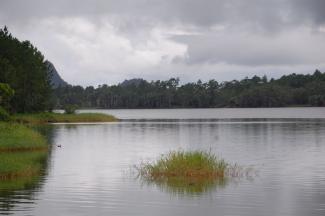Governance
“Digitalisation and advanced technologies must be applied”

Can you give a quick overview of the water situation in Mauritius?
Considering the natural supply, Mauritius is not a water-scarce island – nevertheless, we experience water shortages. The biggest challenge for the concerned authorities is to supply the people with water on a 24 hours per day basis and with good pressure. Actually, that should not be too difficult. Mauritius is a small and densely populated country. Almost every household is connected to the water-distribution system. Moreover, due to our volcanic topography, the water runs down from high altitude areas to lower altitude ones; therefore, the water from precipitation runs to the reservoirs and to consumers literally by itself. But there are two important shortcomings: first of all, only a very small amount of rain water is captured for use in the dry season. In 2018, a mere 7.6 % of the total available rainfall was captured through our storage system. On average, it is an annual seven to nine percent. Second, up to 40 % is classified as so-called non-revenue water. That includes physical leakages due to broken pipes et cet-era, commercial losses due to defective meters and illegal connections and also unpaid water such as water used by firefighters, for example. I think it should be made public how big the share of each type of non-rev-enue water is, but it is not. The water sector is not transparent.
So, as a result, the people in Mauritius do not have a reliable water supply?
That’s right. Reliability involves a timely service, with the required quality and quantity to be provided around the clock. Problems include low pressure, sudden breakdowns and seasonal variations. Some regions have only two or three hours of water per day. That is definitely not enough. At least during daytime there should be running water in every household. Pressure matters too. If it is too low, dirty water can enter the pipes, because they are very old and not properly maintained. The shortages occur mostly in the dry season. More than 75 % of rainfall is in the months from November to April. After two or three months with limited rain – which we experience every year – the water in the reservoirs is low.
What is the solution?
I see two possibilities: one is to store more water. For that purpose, more reservoirs must be built. The other option is to cut the losses – and thus double the amount of water available for use. For a start, the old pipes should be replaced. Both options cost a lot of money. That is why I am not very optimistic that either one of them will materialise.
Why not?
The price the consumers pay for water in Mauritius is very low: aggregating all uses, it is only 12 rupees ($ 0.33) per cubic metre. Moreover, the first six cubic metres per month are free of charge. Many households don’t exceed that limit, so they don’t pay for water at all. The Central Water Authority, which is in charge of the distribution system, does not generate enough revenue to significantly improve the infrastructure. On the other hand, the Water Resources Unit at the Ministry of Energy and Public Utilities, which is in charge of building reservoirs, is completely dependent on public money. So either way does not work without the state paying for it – and unfortunately, water is only one of the many priorities of the government, competing with other infrastructural development.
From your point of view, is there a way to achieve good water supply in spite of the financial problems?
The whole system must change. Water should not be free – you have to pay for what you use. The provision of water to the people includes the storage and distribution system. Once a good storage system is in place, it is available for everyone. People tend to think that water would flow naturally to them, but one way or another, infrastructures must be paid for. The right water price will make people waste less, more-over. The water tariff should go up, and customers’ money should finance the storage and distribution system. Billions of rupees are needed to construct the necessary dams and reservoirs and to maintain the distribution network. In the past 15 years, only one single dam has been constructed in Mauritius. The equation is simple: no funds, no dams. However, all politicians know that it would be a hard sell. That said, I did research on whether households would be willing to pay more if water supply was made more reliable through improvements in storage and distribution. Almost 87 % from a sample of 400 households agreed to pay more (a 27 % increase of the average water bill) if the money was strictly channelled to infrastructural development to provide reliable water supply on a 24 hour per day basis.
But would uninterrupted water supply not help to win votes?
The government’s strategy is different. In the past term, a scheme to subsidise the purchase of water tanks was introduced. This was what it did to solve the water shortage problem. The vast majority of households now have a tank. According to the census of 2011, the last reliable data we have, it was almost half of the households back then, but this figure must be much higher at present. So when there is no water supply from the public system, people can use the stored water. But one needs to have one’s own land or an appropriate roof to install the tank. Installation and maintenance cost money moreover, so the poorest people lose out. The scheme has created a disparity among those who can afford a tank and those who cannot, leading to different standards of living. That’s not good. However, this scheme is conducive from the perspective of politicians who want to make people happy with continuous supply of water.
What about commercial users?
Major consumers in agriculture, the garment industry and tourism are encouraged to harvest their own water. They need uninterrupted water supply, so their motivation is strong to install their own systems to catch and store water. You can see a lot of them on the island. But that doesn’t solve the problems of private households, of course.
That sounds like a dead-end situation.
Yes, and it will even get worse. The demand will surely go up, so water shortages are set to increase. Reasons include population growth, more tourists coming to Mauritius and more foreigners settling here since they are now allowed to buy apartments. So the pressure on the water system will grow.
What about climate change? Does that play a role too?
It definitely does. The rains used to set in early in January. Now they start at the end of January. Climate change is shifting the seasons, and the dry period, in which we have problems with the water supply, is getting longer. The other thing is that we now experience torrential rains more often than we used to. After two or three hours of heavy downpour everything is flooded. That is a new challenge. There is more rain, but on fewer days. Most of that water goes directly into the sea. We must find a way to capture it.
The floodings seem to be severe, causing a lot of damage and hardship. Is the drainage system up to task?
No, it is old and not well maintained. Open drains get blocked by debris when there is a storm. Too much urbanisation and too much land sealing play a role too. We Mauritians are not good at planning ahead; we just react to what happens, for instance, when there is a natural disaster. In 2013, we had severe flooding which caused the death of 11 people in Port Louis, the capital city. In response, the Natural Disaster Risk Reduction and Management Centre was established and a warning system installed. However, I don’t think it is a state-of-the-art alert system. Digitalisation and advanced technologies must be applied to map water flows, understand ecological dynamics, assess vulnerability, forecast changes in land uses et cetera. Besides, the people do not check the warning system regularly. Episodes of flooding after every heavy rain prove the severity of this problem.
Links
Peeroo, A., and Sultan, R., 2016: Governance and economic accounting issues in the Mauritian water sector. Toward sustainable management of a natural resource.
https://www.researchgate.net/publication/314119102_Governance_and_Economic_Accounting_Issues_in_the_Mauritian_Water_Sector_toward_Sustainable_Management_of_a_Natural_Resource
Sultan, R., 2020: Accounting for the non-market benefits of water supply improvements to ensure sustainability. The case of Mauritius. International Journal of Critical Accounting (forthcoming).
Riad Sultan is a senior lecturer in economics at the University of Mauritius.
https://www.uom.ac.mu/fssh/des/








